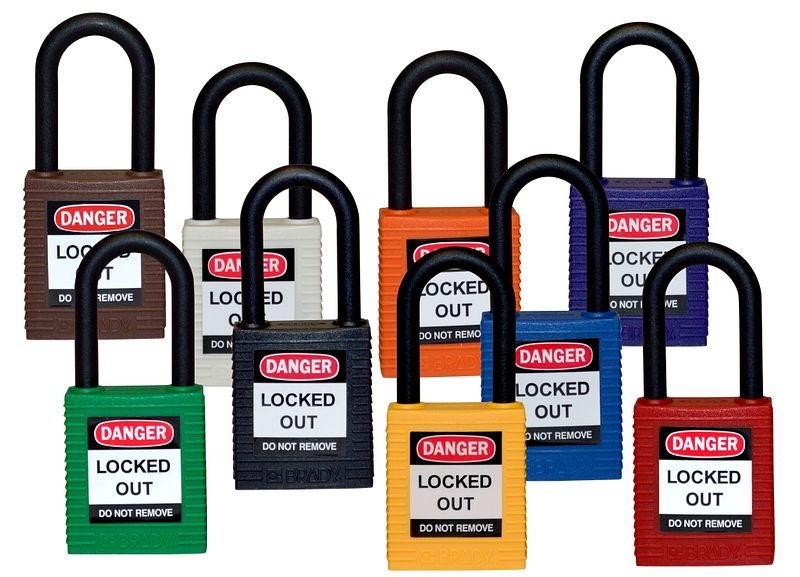Lockout-Tagout Colour Coding for Padlocks
- Posted on
- 0

When should you use which color safety padlock?
Safety padlocks are at the heart of any Lockout-Tagout (LOTO) system. They come in various colors, materials, and sizes. But the question often arises: why use different colours? In this article, we explain the benefits of colour coding, the official guidelines from both OSHA and our partner Brady, and provide tips on how to implement your own colour system in the workplace.
What is Lockout-Tagout, and why is colour important?
Lockout-Tagout is a safety procedure that ensures machines do not start unexpectedly or release energy during maintenance. It consists of physically locking out (lock-out) the energy source and clearly labeling (tag-out) the locked-out machine. This ensures all personnel know the equipment must not be used until maintenance is completed and the lockout is removed.
- Quickly identify risks: Employees and contractors can immediately see that a machine is locked and identify the type of hazard or responsible person at a glance.
- Avoid confusion: When multiple technicians, departments, or contractors are involved, color coding helps distinguish responsibilities.
- Raise safety awareness: A visible and consistent color system reinforces Lockout-Tagout recognition and strengthens workplace safety culture.
OSHA Guidelines for Colour Coding
The U.S. Occupational Safety and Health Administration (OSHA) recommends that lockout products (including padlocks) be clearly distinguishable in color, shape, and size. While OSHA doesn’t enforce specific color standards, they suggest the following system:
- Red: Danger
- Yellow: Caution
- Orange: Warning
- Neon Orange: Biohazard
Het idee hierachter is dat de kleur van het hangslot een signaalfunctie heeft over het type risico of waarschuwing dat er geldt. In een oogopslag zie je: rood staat voor acuut gevaar, geel vraagt om oplettendheid, oranje duidt een algemene waarschuwing aan en neonoranje kan wijzen op besmettingsgevaar of biologische risico’s.
Brady's colour coding guidelines
Our partner Brady, a leading manufacturer of safety and identification solutions, uses a different approach focused on who applied the lockout rather than the type of hazard. Brady suggests:
- Red: For in-house maintenance technicians
- Blue: For contractors and external workers
- Yellow: For the electrical department
- Orange: For temporary or external specialists
This system makes it instantly clear who applied the lock and helps coordinate more complex maintenance projects.
How to Choose the Right Color Coding System
While OSHA and Brady provide useful guidance, you're not legally required to follow these exact color schemes. Every organization can define its own colour rules as long as padlocks are clearly distinguishable.
Things to Consider When Setting Up Your Color Coding System
-- Risk type: If you work with chemicals, consider reserving a color for chemical hazards. The same goes for biological or explosion risks.
- Department-based:Assign colors to departments (e.g., electrical, mechanical, HR/facilities) for clear responsibility.
- User levels: Assign colors based on function or authority – such as trainees, operators, supervisors, or external experts.
- Compliance & communication: Make sure the color system is well communicated via instructions, toolbox talks, and signage throughout the workplace.
Practical Tips for Effective Colour Management
- Use colour charts and posters: Display a legend of your color system at strategic points like time clocks, tool boards, or entrances.
- Combine with clear labels Use labels alongside color to prevent confusion, especially for color-blind employees or new workers.
- Keep it manageable: Avoid overly complex systems (e.g., 10 colors for 10 scenarios) that risk running out of specific padlocks.
- Train all employees: Consistency is key—ensure not just technicians but everyone understands the color system and LOTO rules.
Safety padlocks are essential to any LOTO system. Whether you follow OSHA's risk-based approach or Brady's responsibility-based system, the key is to implement a clear, consistent plan that suits your organization’s structure and safety culture.
Looking for expert advice or the right safety padlocks for your team? Visit www.uniquesafetyproducts.com or browse the wide range at our Lockout-Tagout Shop!



















Comments
Be the first to comment...